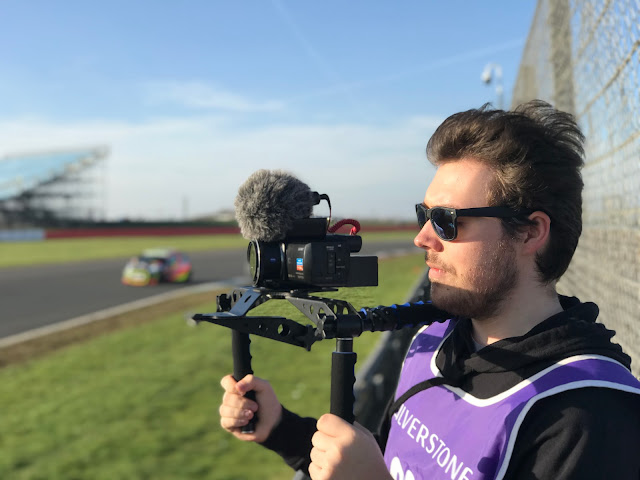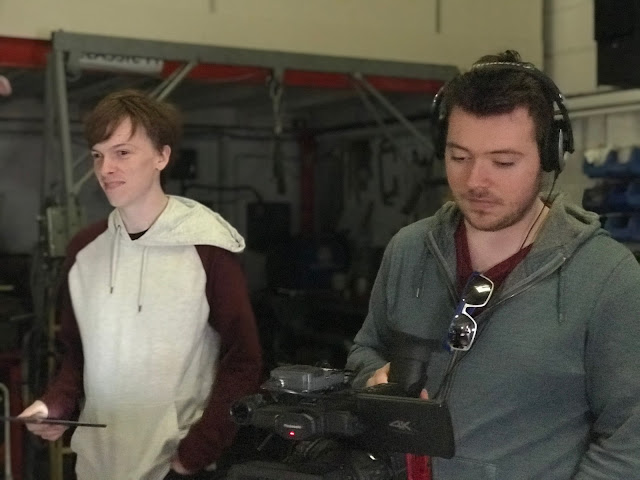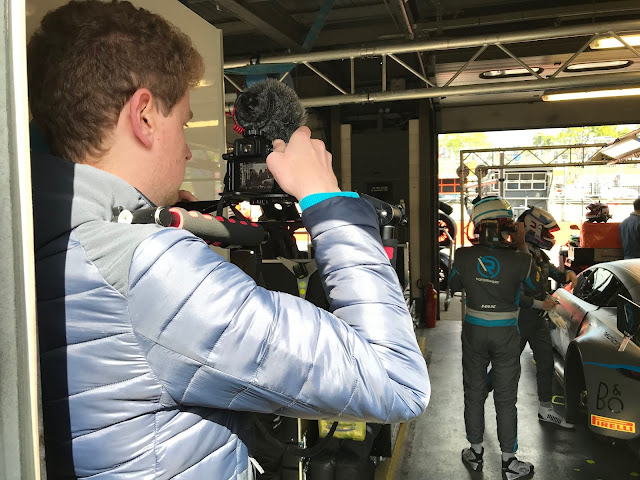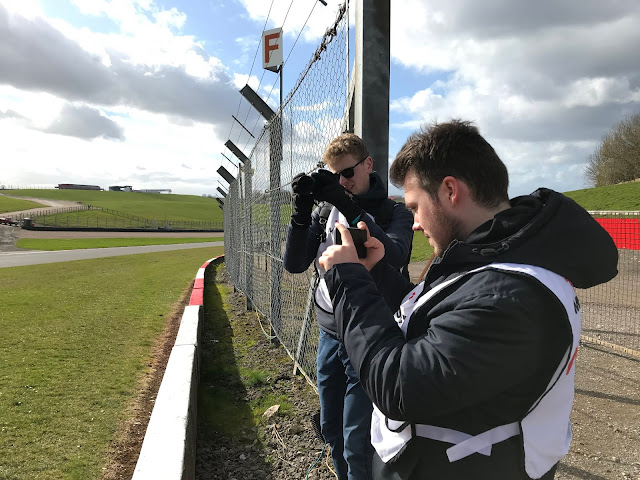As we are about to head into the most important months of the year, I wanted to further my research into being a director and contributor. I had spent an extensive amount of time researching my roles in pre-production, but I believe that I can always improve and learn ways to be better within our team. As my role of scriptwriter is mostly complete, I will be focusing on being the director and contributor in this research blog post.
Director
One of my issues in this documentary is that when I am in front of the screen, I cannot be the director in the traditional sense. All of my plans need to be made before we go into a shoot date and all the information I need to get across has to be done so in advance along with it. There have been a couple of occasions so far in our filming in which we have disagreed on what we should do which has led to us all feeling like we could have done better on the day. This is definitely somewhere where I could improve as a director. Even though I cannot direct when being the contributor, when there is some downtime I should focus on bringing the team together.
"One of the main issues I've seen working on sets with amateur directors is one that the video seems to address over and over again: take care of your team... You could be the most creative, groundbreaking...director in the history of the universe, but if you don't know how to be a leader and rally your team to work together and be creative and be excited about the work they're doing on-set, it'll show in your film." (nofilmschool, 2015). I feel that on a few occasions so far I have been dragged into issues, even if they have been small, which has led to the overall crew morale dropping at some of the shoot dates so far. I now know that it is part of my job to ensure that the crew doing their job and also happy and feel like they are capable of doing their best. Part of this will be achieved through even more detailed plans to ensure the crew are completely aware of what I want from each shoot date. I know as a director I can go into further detail and that this will only help the final film as well as crew spirits. Alongside this, I will be doing my best to allow the crew to relax into their role, as I have been struggling to take a step back and allow this as a contributor.
"Tension shows up on-screen, believe it or not, so it's imperative to not only express your creative vision for your project, but to express your respect and appreciation to your cast and crew." (nofilmschool, 2015). I am learning and improving and I feel that once I am able to fully let go on these days, Cailan and George will be able to do their best too. There is a lot of trust involved in this, but I am absolutely sure that it is possible to achieve within our team.
Something I am aware of so far is that I could continue to improve my communication before shoot days to ensure the actual shoot goes to plan. Going into every one of these, I have a clear plan of what I want to get out of it, but there is a limit to how much detail can be shown with plans and shotlists. It is vitally important that I speak more about my plans in person or even through a voice chat, to ensure I maximise the amount of information I can get across to the crew
"A good director must possess strong communication skills. If the director cannot be understood, the production team will not be able to fulfill the production design. The director may have a brilliant idea in mind but if they cannot communicate clearly it is all for naught." (ossiemills, 2011). Knowing this makes me believe that I need to spend extra time before every shoot having this key conversation with the D.O.P and producer, as they need to know my thoughts to ensure the shoot goes to plan. Doing this will also allow the rest of the team to speak about different ways we could film the scenes which would ensure the whole crew is having an input into how the film will look. My plan is to hold a meeting a week or at least a few days before each shoot, allowing feedback to be given to me so I can adapt my plans to what the whole crew thinks. As has been mentioned in my work already, I will be setting out my plans after these conversations but these will mention all the shots I require, but not saying that this is all we need to film. I am very aware in a documentary with so many unpredictable moments, that the production team needs to be aware at all times of the need to capture important actuality and b-roll which will be essential in the edit. It is impossible to plan this actuality so it will be up to the team to be proactive and get these shots.

A part of my role that I know will need work is that of being a director in the edit. I understand what I need to be doing before we film, but knowing how to be a good director in the edit is just as essential.
"A good director will have a good sense of timing. The timing will control whether or not cuts or dissolves are used, the lengths of scenes, the type of shots that are used, the pause lengths, etc. Timing is the intangible element that is hard to put your hand on, but you’ll know when you don’t like it." (ossiemills, 2011). This shows the importance of a good relationship and trust between myself and George who will be editing the film. We have disagreed on a few issues so far and we have overcome these through lengthy discussions. I personally feel we need to be able to work out issues quicker as we will not have unlimited time in the edit to do so. I will be working with George on production flow between us in the edit to ensure the tension does not rise and we manage to have a productive and enjoyable editing phase.
"Great filmmakers must be able to make firm decisions and stick to them to help ensure production stays on track." (http://filmschools.com, 2019). The edit will be hard as we will have a number of sequences that undoubtedly have to be cut due to our time limit. This is where I can impose an educated view on the story in the edit. I will need to be able to make these hard decisions and have back up from my team for it. As well as what we cut, I will also need to be decisive on what parts of individual scenes are trimmed. We have long sequences and getting the right point will be essential. We will work out what works as a team but ultimately I need to be the one making the decisions about the story. But this links to my earlier point about listening to the crew. I hope we will have all understood each other enough by this stage and that we agree on a lot of the decisions in the edit and do not take anything personally. I am ready for the challenge of making these key decisions in this project, as I know it is heavily linked to its success.

The last part of my extended research into being a better director looks at being decisive under pressure.
"Great filmmakers are able to handle pressure well. They understand that complications will arise during the filmmaking process and are able to handle the stress" (http://filmschools.com, 2019). Some of the decisions I will be making throughout this project will be extremely tough at the time but they will ultimately ensure the documentary is one that is consistent and tonally correct throughout. I know we can work well as a team and it is part of my duty to bring us together, especially when we may disagree on something. It is a learning process for me and I have felt the stress on a lot of occasions in this project so far, but I do feel I have made the right decisions on the majority of occasions for the overall project. This mostly leads to re-shooting and test shooting sequences or scheduling within the limited time available. It has been very tough to ensure we are all available for the upcoming shoot dates but I see this as part of the challenge we have taken on with this project.
"Great filmmakers have terrific vision and can see the film from its conception through to its final product. They never lose sight of the ultimate goal. Great filmmakers must (also) be able to make firm decisions and stick to them to help ensure production stays on track." (http://filmschools.com, 2019). A lot of my decisions so far are looking towards the end goal and making sure we leave ourselves enough time, in the end, to get the edit together. This is the reason I have been so involved in items such as scheduling as I want to ensure we do not put ourselves into a bad place. I know what the goal is for this project and I am doing everything in my power to ensure it happens, I know the resources I have available to me and I am understanding how I can best use them on this project. As the director, I am continually thinking of ways that I can get the most out of people and understanding their way of working to allow them to be at their most effective. I am happy to have involved myself so much in the small details as I think it allows everyone to perform at their best. This research into being a director has allowed me to understand further ways that I can improve as well as getting the most out of others. I am excited to put this research into place and get to work on our next filming days!

Contributor
Working out how I can become a better contributor has certainly been one of my hardest challenges in the project so far. I have already involved myself as a director and writer on this course before, but being a contributor is a role I have not researched much over the past three years. It is certainly an exciting challenge for me as I am always looking to improve myself in every area, but I have found the balance between being a contributor and my other roles to be a tough challenge in this project. Finding research on contributors and how to be a better one was a very tough task, so I expanded my research into presenters, as I will be able to take a lot of the advice for that role as it is so similar.
Being a good face for the documentary starts with having an interest in the subject.
"A good presenter therefore understands the process of television production. They should be interested and involved in the subject they are presenting and they should have a good understanding of the audience – who is watching and why – because a good presenter is able to engage with the viewers." (http://wanttoworkintelevision.com, 2011). In this regard, I am already doing something right as I was the one who wrote the project and the one who has the dream and interest in going on this journey. I have been told on a couple of occasions so far that I am pretty good in front of the camera which allows me to think that I should be somewhat engaging to the viewer. Motorsport is exciting so that will help my cause, but allowing myself to relax before we start filming will allow the messages I am trying to tell in this story to be brought out in the best way possible. I know that I am not the best contributor in the world, but at the same time, one of the ways I can improve is by understanding myself and how I work. I already see marked progress of my on-screen presence since the first shoot dates over a month ago. This is partly thanks to research like this along with having a team I trust behind me. I know by the time we get into the last few filming days that I will feel at home being filmed without asking any questions. However, I realise I am not there yet and I still need to allow them to be a gap between myself and the camera and the decisions being made at the moment.

An interview with TV presenter Dermot O'Leary gave me some useful tips at how I could improve my screen presence and allow myself to be connected to the viewer:
"Whether it’s in one-on-one interviews, with the studio audience or down the camera, an ability to connect and communicate is vital. If a presenter can do all three at once, making everyone think they’re talking directly to them, they’re onto a winner." (telegraph.co.uk, 2016). I have been looking at documentaries which are similar to the one we are trying to create to allow me to work on how I communicate my key thoughts as the main contributor. I have worked on my delivery, even as a contributor, because otherwise my points could easily be mixed within other messages if I do not make the key points clear. I've also seen in my work so far that it is much easier to connect with a presenter or contributor if they come across well when on screen.
"The most elusive attribute of all: the ability to gel with viewers, who must like you enough to invite them into their home and spend hours in your company. Which, let’s face it, isn’t something many of us want to do with our own families." (telegraph.co.uk, 2016). I doubt I will be able to connect to the viewer in the way a TV presenter would, but I hope my passion for the subject matter along with my personality will mean that the viewer will be able to connect to me on a somewhat personal level. It is important that the viewer can do this, as it allows the story to come across better. The more a viewer can relate to me, the better that connection becomes, which will mean the ending moment will hopefully mean as much to them as it does for me. I want to make it a journey for myself and the viewer, and being a good and likeable contributor is a part of that.
External factors such as facial expressions and posture are things I would not expect to be thinking about, but when I am spending so much time looking at the small details, this is something I should be taking note of.
"Most of the experts agree that the majority of communication takes place in a non-verbal manner. This means that your posture, gestures, and facial expressions can change the ways that your viewers receive your messages. As you film, consider what things you might be doing that could send an unintentional message to your viewers." (uscreen, 2016) This is certainly something I can work on to add the extra small details to this project. The biggest thing I have been told on the run-up to the production of this project is "Just be yourself", which is actually a lot harder than it sounds when you have a production crew with you, filming every move.
"Nothing, absolutely nothing succeeds like enthusiasm - it's infectious. Once the audience spot that you have a passion for your subject they immediately begin to warm to you and will ignore any imperfections or omissions in your presentation." (virtualstudio, 2010)
I have determined that the best way to work on this is to yet again to try and forget the cameras are there and focus on my journey and what I am doing on any given day. I have seen the progress in my overall appearance in front of the camera since the start of filming, but it can still improve.
"One of the hardest things about presenting on camera is that you can easily become hyperaware of your flaws. In most cases, you will be your own toughest critic. Over time, self-criticism can start to drain your energy and chip away at your confidence." (uscreen, 2016) There is not much I can do in terms of practice but I need to remember to reflect after every shoot date and see what I could do better. This will allow me to come across in the most natural way possible.
While I need to be natural within this documentary for it to be grounded, I have started to work on my speaking skills so my point comes across in a much clearer way than it would have done before.
"No one wants to hear a rambling speaker. The moment you start rambling people will begin to tune you out. Have clarity with it comes to your ideas, opinions, philosophy, and beliefs. Once you are clear and focused, start by communicating your thoughts while continuing to modify and clarify them even more." (magneticspeaking, 2019). Being honest with myself, I know I am prone to ramble at times and I have got a few comments on my YouTube page about this over the years. The way I am tackling it for this project is to think about the question in a little more detail before I answer it. Sometimes the most powerful message is the one that comes naturally, sometimes it is one that has been thought about, it is all down to the situation. I am learning when I need to make my points more clear and it is allowing some of the scenes we are filming to be much more powerful. An example of a sequence in which we need a clear and concise answer is the Diary Room. Of course, these answers need to come from the heart, but they need to get to the point. In our tests, it may be a few takes for us to get to the point where we are happy. These shots still look natural but they were mostly not done on the first shoot. Making sure the answer is what we want for the story is very important as the viewer does not want to sit through me repeating points over the 20 minutes. This is also where we will need to work on the edit as it will allow slight editing of any annoying quirks or sayings I have throughout the filming process.
Overall, I can see the progress I have made so far in this project as a presenter and my biggest aim is to continue to develop and relax into my role further. The best I can really do is to be myself. Saying this, as detailed in this research, there are small areas which I can work on to allow my personality to come across the right way. I am happy I conducted this research as it has allowed me to fully realise what I need to work on going forward. It gives me clear aims as to what I should be doing and why it is important to do so.
References
nofilmschool, 2015 https://nofilmschool.com/2015/04/15-tips-becoming-better-director
ossiemills, 2011 http://ossiemills.org/2011/01/social-media-outlets-for-non-profits/
http://filmschools.com, 2019 http://filmschools.com/resources/top-10-qualities-of-a-great-filmmaker
http://wanttoworkintelevision.com, 2011 http://wanttoworkintelevision.com/what-makes-a-good-television-presenter/
telegraph.co.uk, 2016 https://www.telegraph.co.uk/tv/2016/09/03/what-makes-a-good-tv-presenter-x-factors-dermot-oleary-makes-it/
uscreen, 2016 https://www.uscreen.tv/blog/10-tips-for-presenting-like-a-pro-on-camera/
virtualstudio, 2010 http://www.virtualstudio.tv/blog/post/13-10-tips-to-become-a-better-presenter
magneticspeaking, 2019 https://magneticspeaking.com/8-qualities-make-great-speakers-unforgettable/